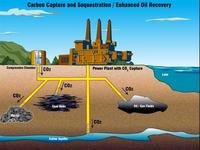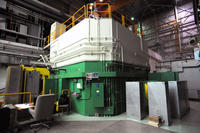-
Nations' nuclear ambitions not discouraged by few suppliers
Twenty-nine countries are considering constructing their first nuclear power plant. There are doubts as to which of these nuclear “newcomer” countries can actually succeed and join the thirty-one countries that already operate nuclear reactors. If even half of the national plans for nuclear power plants materialize, the geography of nuclear energy would radically change and could revitalize a stagnant industry. But given the obstacles to starting a national nuclear power program even for rich and stable countries, it’s not likely to happen quickly elsewhere.
-
-
Abandoned mine offers clues about permanent CO2 sequestration
Power plants and other industries are responsible for more than 60 percent of global CO2 emissions, according to the International Energy Agency. Sequestering the CO2 in magnesite deposits would prevent the gas from entering the atmosphere and warming the planet. Stanford University researchers, studyingveins of pure magnesium carbonate, or magnesite — a chalky mineral made of carbon dioxide (CO2) and magnesium – in an abandoned mine in the Red Mountain, propose a novel technique for converting CO2 into solid magnesite, making CO2 sequestration feasible.
-
-
Minimizing power grid disruptions from wind power
Researchers have found that an increase in the use of wind power generation can make the power grid more fragile and susceptible to disruptions. The researchers, however, did not just identify the problem — they have also devised a technique for coordinating wind power generation and energy storage in order to minimize the potential for such power disruptions.
-
-
Carbon capture technology vital for meeting climate targets

In 2010, coal, oil, and gas supplied more than 80 percent of the world’s total primary energy supply — and the demand for energy is projected to increase by two to three times by 2100. Studies show that without policies to cut greenhouse gas emissions, fossil fuels will remain the major energy source in 2100, with resulting increases in greenhouse gas emissions. Where should policymakers focus their carbon mitigation efforts, however? Which technologies hold the most promise?Scientists say that a combination of carbon capture and storage (CCS) and bioenergy has advantages over solar, wind, and nuclear because it can lead to negative emissions. Moreover, bioenergy can be converted into liquid and gaseous fuels which are easily storable and can be readily used by current transportation systems,thus taking some pressure off other sector in terms of required mitigation effort.
-
-
How effective are renewable energy subsidies? It depends
Renewable energy subsidies have led to explosive growth in wind power installations across the United States, especially in the Midwest and Texas. Electricity produced by wind is emission free, so the development of wind-power may reduce aggregate pollution by offsetting production from fossil fuel generated electricity production. Emission rates of fossil fuel generators, however, vary greatly by generator (coal-fired, natural gas, nuclear, hydropower). Thus, the quantity of emissions offset by wind power will depend crucially on which generators reduce their output. In other words, the quantity of pollutants offset by wind power depends crucially on which generators reduce production when wind power comes online.
-
-
Natural gas saves water, reduces drought vulnerability
A new study finds that in Texas, the U.S. state that annually generates the most electricity, the transition from coal to natural gas for electricity generation is saving water and making the state less vulnerable to drought. Even though exploration for natural gas through hydraulic fracturing requires significant water consumption in Texas, the new consumption is easily offset by the overall water efficiencies of shifting electricity generation from coal to natural gas. The researchers estimate that water saved by shifting a power plant from coal to natural gas is 25 to 50 times as great as the amount of water used in hydraulic fracturing to extract the natural gas.
-
-
One step closer to nuclear fusion power station
Researchers have made a technological breakthrough crucial to the success of nuclear fusion reactors, allowing for clean, inexhaustible energy generation based on the workings of the stars in our galaxy. At the heart of the new development is an ingenious and robust superconducting cable system. This makes for a remarkably strong magnetic field that controls the very hot, energy-generating plasma in the reactor core, laying the foundation for nuclear fusion. The new cables are far less susceptible to heating due to a clever way of interweaving, which allows for a significant increase in the possibilities to control the plasma.
-
-
U.S. loses clean electricity as nuclear power plants keep closing
Four nuclear power plants, sources of low-emissions electricity, have announced closings this year. The main reason: the increasing availability of cheap natural gas as a result of fracking. If plants continue to shut down instead of extending operations, the United States risks losing 60 percent of its clean electricity starting in 2030, according to a new report by the American Physical Society (APS). The APS calls on socially responsible investors to encourage utilities to consider carbon emissions in business decisions.
-
-
Virtual wall to build invisible barrier for oil spills
The outer shell of a droplet of oil on a surface has a thin skin which allows it to hold its shape like a small dome; this shell is referred to as the liquid’s surface tension. Now, researchers have developed a technique to form a virtual wall for oily liquids that will help confine them to a certain area, aiding researchers who are studying these complex molecules. This development will have future implications in the guided delivery of oil and effective blockage of oil spreading.
-
-
Using biological organisms to convert natural gas to liquid transportation fuel

Researchers will use their expertise in protein expression, enzyme engineering, and high-throughput assays as part of a multiproject, $34 million effort by the Advanced Research Projects Agency-Energy (ARPA-E) aimed at developing advanced biocatalyst technologies that can convert natural gas to liquid fuel for transportation.
-
-
DOE to resume transient testing of nuclear fuels and materials

Transient testing of nuclear fuel involves placing fuel or material into the core of a nuclear reactor and subjecting it to short bursts of intense, high-power radiation in order to analyze the effects of the radiation. The Idaho National Laboratory (INL) Transient Reactor Test Facility began operating on 23 February 1959 and was a principal reactor safety testing facility in the United States for thirty-five years. The U.S. Department of Energy invites the public to read and comment on a draft environmental assessment it has prepared for a proposal to resume transient testing of nuclear fuels and materials.
-
-
U.S. oil production exceeds imports for first time in two decades

The United States is well on its way to energy independence, with the Obama administration announcing Wednesday that domestic oil production surpassed imports for the first time in nearly two decades. A report by the U.S. Energy Information Administration (EIA) offers proof that the United States has managed both to increase domestic oil and gas drilling and reduce the nation’s carbon emissions, which have dropped to a 20-year low. Since 2008, U.S. crude oil output has increased 50 percent, while imports have fallen about 20 percent.
-
-
Drive-by charging: Advancing wireless power transfer for vehicles
Researchers have developed new technology and techniques for transmitting power wirelessly from a stationary source to a mobile receiver — moving engineers closer to their goal of creating highway “stations” that can recharge electric vehicles wirelessly as the vehicles drive by.
-
-
Japan hopes off-shore wind turbines can replace shut-down nukes

Japan inaugurated a floating offshore wind turbine on Monday, symbolizing the country’s effort to reduce its dependency on nuclear energy and fossil fuels and shift to renewable energy sources. The floating platform is anchored thirteen miles offshore from the Fukushima Daiichi nuclear power plant, which has been out of commission since the reactor’s meltdown disasterof March 2011. The platform is anchored to the seabed 400 feet below surface. It is the first project of its kind in Japan, and it aims to show that the country can exploit the country’s powerful offshore winds to create a sustainable energy source.
-
-
Climate scientists say renewables are not enough
Some of the world’s top climatologists have declared their support for nuclear energy as a complementary energy source, alongside wind and solar as energy, which would cut fossil fuel pollution and reduce the growth of global warming. The scientists say that opposing fossil fuels and promoting renewable energy sources offer but a limited solution.
-
More headlines
The long view
Strengthening the Grid’s ‘Backbone’ with Hydropower
Argonne-led studies investigate how hydropower could help add more clean energy to the grid, how it generates value as grids add more renewable energy, and how liner technology can improve hydropower efficiency.
LNG Exports Have Had No Impact on Domestic Energy Costs: Analysis
U.S. liquified natural gas (LNG) exports have not had any sustained and significant direct impact on U.S. natural gas prices and have, in fact, spurred production and productivity gains, which contribute to downward pressure on domestic prices.
